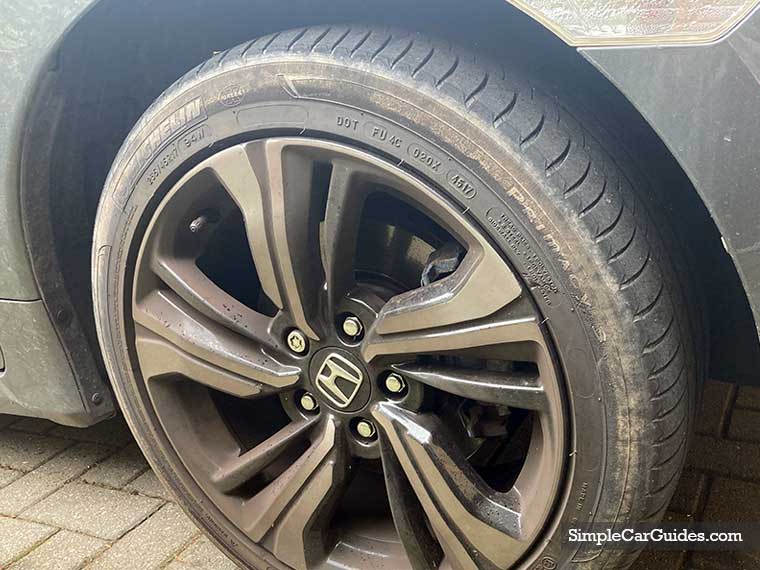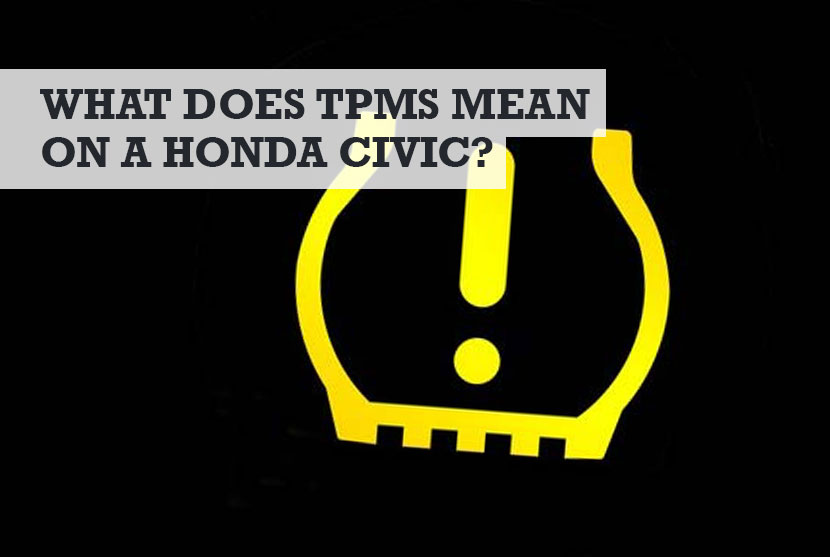There’s nothing more anxiety inducing than driving your Honda Civic when suddenly the TPMS warming light comes on. It’s even more worrying when you know what it means. Read this quick guide to what causes TPMS light to come on in your Civic, what you need to do, and how to calibrate, reset, or fix it.
What does TPMS mean on a Honda Civic? TPMS on a Honda Civic means “Tire Pressure Monitoring System”. This is a security and safety feature designed to tell the driver via a TPMS light when the Civic’s tires are losing pressure. Honda Civic TPMS can sense the smallest change in tire pressure.
That’s the simple answer, but should you worry if the TPMS light comes on in your Honda Civic when driving, and what causes it. All you need to know is below.
Honda Civic TPMS meaning and causes
With modern developments in technology, the automotive industry have added more and more advanced dashboard indicators to help warn the drivers of vehicle faults. Given that one of the most common causes of car accidents is bad tires, you can understand why the TPMS (tire pressure monitoring system) is so important.
Honda Civics are no different, as they include a TPMS light, and here what it all means and why it’s happening with the most common questions drivers need to know.
What does check TPMS system mean on a Honda Civic?
The Honda Civic TPMS is an abbreviation for “Tire Pressure Monitoring System”. This in-built security system is designed to keep you safe and prevent you from having an accident due to an emergency tire failure.
The Honda Civic is equipped with an indirect or direct TPMS system depending on the year of manufacture. In the direct TPMS system, TPMS is measured by sensors are fitted in the wheel, while in the indirect TPMS system, TPMS is measured by wheel speed through the ABS.
What causes the Honda Civic TPMS light to come on?
The Honda Civic TPMS warning light will come on when the sensor feels a change in tire pressure. The TPMS tracks your Civic’s tire air pressure and is designed to alert you when there is excessive tread wear, decreased efficiency, decreased traction, increased chance of a blowout, decreased load-carrying capability, or low tire pressure.

It can sense the slightest of changes, and when triggered, the TPMS alert will appear on your dashboard as a yellow warning light that resembles a cutaway tire with an exclamation point. “Tire Pressures Low” is a visible warning indicator on the latest Honda Civic vehicles.
Handy Hint: Another system light that will often go off is the enter code on a Honda Civic radio. Here’s what you need to do to get it reset.
Can I drive my car with the TPMS light on?
I have driven my Honda Civic car with the TPMS light on, but only for a short while until I could safely stop. The TPMS light came on whilst I was on a highway, so I had to continue driving 2 miles until I could pull off.
However, if you can, I would say do not drive your car with the TPMS light on. “Safety first” as the saying goes.
Driving your Honda Civic with the TPMS indication should not be considered safe. Without stopping to check the tires, there is no way to know how quickly air is leaving your tire or how long it has been under or overinflated.
If you notice the TPMS light comes on in your Honda Civic, the best thing to do is to safely come to a stop, and perform a manual check on each tire’s current level of inflation with a tire pressure gauge.
You might notice a nail or screw in the tire like I did, and then have change to the spare.
At this point, I would recommend you buy a tire pressure gauge on Amazon, so you can do that check safely at the roadside.
However, what happens if you notice the TPMS indicator while driving in a remote area or don’t have a pressure gauge? In that case, it is best to reduce your speed and carefully drive to the service station to inspect your tire and attend to the possible cause of the TPMS warning.
What to check on your Honda Civic after a TPMS light warning
If your Honda Civic TPMS has been triggered, you should act as quickly as possible. Low tire pressure can cause excessive tire wear, reduce vehicle efficiency, and pose the risk of a tire blowout while driving.
To turn off the alarm and avoid any of the aforementioned situations, do the following:
- Pull off the road for safety.
- Visually inspect your tires to verify there are no punctures or damage.
- Make sure your tires aren’t underinflated.
- Fill the tire (or tires) to the necessary pressure with an air pump. This specified pressure is indicated on a sticker on the driver’s door sill.
- To reset the TPMS, select “Calibrate” from the touchscreen display settings or “Calibrate” from the steering wheel buttons on an older model (more detailed instructions are lower down the page).
If the preceding procedure doesn’t work, try driving gently for ten minutes to get it working properly again.
If the TPMS light is still on after following the steps above, and you recently replaced tires, you have another problem. Because some TPMS systems are affected by tire diameters, as a result, only use the tire that came with your car.
Emergency tire sealants like Fix-A-Flat or Slime, on the other hand, can cause your TPMS sensor to malfunction. As a result, when your tire has been fixed, the TPMS device should be cleaned with water to remove any sealant that may have come into contact with it.
Did You Know? Poor tyre maintenance was the most common reason for car accidents in Britain last year, new figures published by the Department for Transport (DfT) have revealed. Across the 12-month period, 446 accidents were linked to defective tyres, beating faulty brakes to the top spot by 81. Low pressures, tread that has worn below legal limits and damage are listed as the main tyre issues, suggesting many motorists are neglecting to regularly check the condition of their car’s tyres.
Via www.autocar.co.uk
How can I tell if my Honda Civic TPMS Sensor is faulty?
It is important to note that it is common for a Honda Civic TPMS light to illuminate and then disappear, particularly in areas of the country with cool mornings and warm afternoons.
However, you should only be concerned if the light on your Honda Civic TPMS indicator blinks frequently and the indicator light does not stay solid or go disappear after a while.
This signals that one of the TPMS sensors or probably more than one is faulty or that the system as a whole is malfunctioning.
I have also noticed that the TPMS can go off when you get a new tire fitted. This can sometimes set the TPMS warning off, which will need to be reset. You can find instructions on how to reset the TPMS in the user manual… I’ve also included that lower down the page.
Handy Hint: The green light on your dash means the ECON Mode has been activated. Here’s what it does in a Civic.
How to perform a Honda Civic TPMS reset / calibration
After checking your tire pressure with a gauge and ensuring they are not overinflated or underinflated, you can reset the Honda Civic TPMS, here’s how:
Resetting the Honda Civic TPMS
If the Honda Civic TPMS light remains illuminated after you’ve adjusted your tire pressure, you should consider resetting it. To reset the TPMS light, follow these steps:
- For about 10 minutes, drive at 50 mph. By doing this, your TPMS light should be reset, and the TPMS light should be turned off the next time you start the car.
- Turn the key to the “On” position without starting the car. Hold down the TPMS reset button until the indicator blinks severally, then release the button. You should start the car and let the car run for 20 minutes to allow the sensor to reset. The reset button for the TPMS is usually located under the steering wheel. However, if you can’t find it there, consult your Honda Civic user’s manual for a guide.
A couple of more techniques are more involving and time-consuming for resetting the TPMS light, but they get the job done.
You can start by inflating each of your car tires to 3 PSI above the recommended pressure, then completely deflate them. If the spare tire has a sensor, make sure you do the same to it as well. After deflating all of the tires, re-inflate them to your car’s standard PSI.
Another approach is to open the hood of your car and unplug the positive battery cable while the vehicle is turned off. Turn the key to “On” and honk the horn for some seconds to discharge any remaining power in the vehicle. After that, reconnect the battery.
In some cases, the TPMS might be damaged to the extent that a manual reset will not do the work. And I have already established the fact that it is not safe to drive your car around with the TPMS indicator on.
So instead of driving the car around with a faulty TPMS, it is best if you seek the attention of a professional auto workshop. They will help fix the sensors using professional tools and take away the risk involved in driving around with a bad TPMS.
Honda Civic TPMS calibration
Here’s how to calibrate the Honda Civic TPMS starting off with models that have a touchscreen display on the dash.
- From the Home screen, select Settings.
- Select vehicle.
- Select TPMS Calibration.
- Select Calibrate.
If you don’t have a touchscreen you will need to do this instead:
- Use the steering wheel buttons to make and enter selections in the Driver Information.
- Scroll to the vehicle Settings screen and select it.
- Select TPMS Calibration.
- Select Calibrate.
Honda Civic TPMS sensor replacement cost
If you do need to replace the Civic TPMS sensor, then the replacement cost can range between $100 to $190 (£80 to £145) for the part. You will then need to factor in labor costs which might add an additional $45 to your invoice.
Alternatively you could buy the sensor cheaper online. It’s worth checking the latest Amazon prices.
Of course, prices will very much depend on where you live, and whether you use an official Honda dealer, where prices can be more expensive.
This job cannot be done by a mobile mechanic as the tire will need to be taken off completely so a new TPMS sensor can be fitted.
Conclusion
Drivers use tires to maintain a vehicle’s direction, support a vehicle’s load, deliver braking forces to the road surface, convey traction, absorb road shocks and lots more.
The Honda Civic TPMS system and warning light makes it much easier to manage your car’s operations and closely monitor the situation of your tire – above all, it makes you safe.








